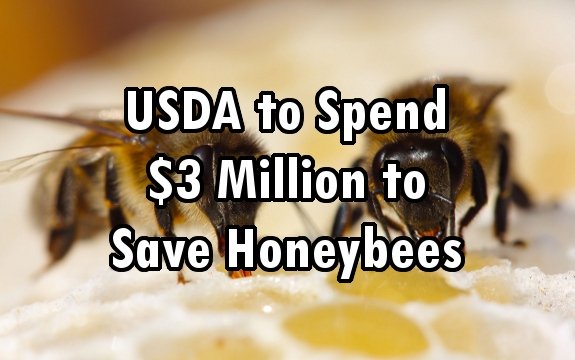USDA to Spend $3 Million to Save Honeybees

 Finally the USDA will do something right for a change. Just this week, the U.S. Department of Agriculture pronounced it would spend $3 million to help the nations honeybees in the Upper Midwest as an act to reverse the damage to bees and colony collapse disorder – linked largely to he abundant use of neonicotinoids and glyphosate.
Finally the USDA will do something right for a change. Just this week, the U.S. Department of Agriculture pronounced it would spend $3 million to help the nations honeybees in the Upper Midwest as an act to reverse the damage to bees and colony collapse disorder – linked largely to he abundant use of neonicotinoids and glyphosate.
Honeybees pollinate an estimated $15 billion in crops every year. Many beekeepers bring their hives to the MidWest during the summer so that they can gather nectar and pollen for food, and then truck them to California to pollinate diverse crops from kiwi to rambutan, apples, alfala and pomegranates.
There has been more than a decade of decline in honeybee numbers, with many theories exisiting for their demise. From pesticides and herbicides, malnutrition, genetically modified crops, viruses, and a lack of genetic biodiversity, our bees have been struggling. Both commercial honeybees and those in the wild have suffered from habitat loss and RoundUp ready poisons.
Over the winter, some honeybee colonies have lost as much as 30% of their hive, and they usually use this time to store up strength and food for future seasons.
Jason Weller, the chief of USDA’s Natural Resources Conservation Service says, this will be “a real shot in the arm” for improving bees’ habitats and food supply.
Farmers will be given millions to reseed alfalfa, clover, and other plants that bees like to dine on. They will also be given funds to help build fences, install water tanks, and make other changes on their farms that keep an area from being inhospitable to bees.
Read: Thousands of Activists Voice Concerns for the Bees
“It’s a win for the livestock guys, and it’s a win for the managed honeybee population,” Weller said. “And it’s a win then for orchardists and other specialty crop producers across the nation because then you’re going to have a healthier, more robust bee population that then goes out and helps pollinate important crops.”
The USDA is targeting just five states since more than 30,000 commercial beekeepers bring their hives to these areas during the warm season. The agency is hoping to get a big bang for their buck – and while this is a great step in the right direction, it doesn’t address the underlying problem(s), such as GMO and the abundant use of neonicotinoids and glyphosate.
Corn and soybean farmers will be given funds to plant cover crops – but if they are mixed in with GMO and herbicides, will this really do the trick? They have also resorted to feeding bees high fructose corn syrup. This has negative effects on people, so why feed it to bees? Why not just restore the natural ecosystem in which bees thrive?
Tim Tucker, who has between 400 and 500 hives at sites in Kansas and Texas, said he may take some of his bees to South Dakota this year because the fields around his farm near Niotaze, Kan., no longer provide much food for them.
“There used to be a lot of small farms in our area that had clover and a variety of crops, whereas in the last 20 years it’s really been corn, soybean and cotton and a little bit of canola,” Tucker said. “But those crops don’t provide a lot of good nectar and pollen for bees.”
The USDA has partnered with Universities to study bee colonies and looks to many entomologists to recommend changes.
“It’s not a cure all,” says Tucker, but “anything we do to help provide habitat for honeybees and for native bees and pollinators is a step.”
Additional Sources:

Whoopdy do the USDA slaps a bandaid on a sucking chest wound.
Typical Useless Government, incapable and inept.